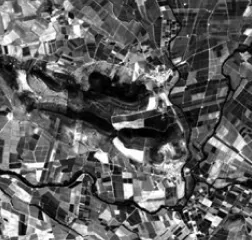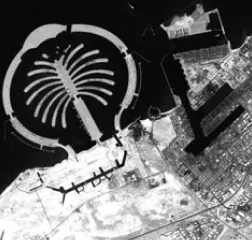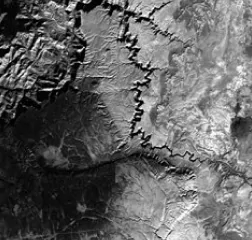Panchromatic And Pansharpened Satellite Imagery
A panchromatic image uses a single band that combines Red, Green, and Blue bands, allowing for a greater spatial resolution. The resulting image does not contain any wavelength-specific information.
Panchromatic images are produced by the same satellites that produce multispectral images – Landsat, DigitalGlobe’s range of satellites, SPOT6/7, and more. Since a panchromatic image is a combination of all three visible bands (red + green + blue), the total intensity of solar radiation is much higher in every pixel compared to a multispectral image. The use of the RGB bands sacrifices color for brightness which explains why all panchromatic images are greyscale images.
Panchromatic Vs Multispectral Imagery
When it comes to detecting brightness differences, a panchromatic image is superior to its multispectral counterpart. This is due to the smaller amounts of light energy available for multispectral bands compared to the Red, Green, and Blue bands. In order to compensate for the lack of brightness, multispectral detectors are required to sample larger areas – which translates into larger pixels and, subsequently, smaller spatial resolution in an image.
What Are Panchromatic Images Used For
A panchromatic band can be used to provide higher spatial resolution for multispectral images. This is achieved using the panchromatic sharpening method where low-resolution color bands are combined (fused) with the high-resolution greyscale band (PAN) to produce a high-resolution color image. A potential drawback of this approach is a certain amount of spectral distortion which can make the classification of objects more difficult.
What Is Panchromatic Sharpening
Panchromatic sharpening is a data fusion technique when a panchromatic image is combined (fused) with a low-resolution multispectral image to achieve a higher spatial resolution while preserving specific spectral attributes. Both images must be taken over the same area. Among the satellites specialized in pansharpening are Landsat 7/8 and SPOT 6/7, as well as DigitalGlobe.
A sharper satellite image reveals more detailed features of the Earth’s surface.
Sharpening Color Composites With Panchromatic Band
The process of sharpening color composites with the panchromatic band can be performed using a number of different methods. Here’s the three most common of them:
HSV Sharpening
The simplest panchromatic sharpening technique is the so-caled HSV Sharpening. It is achieved by swapping a lower-resolution “v” (stands for value) in the HSV with one that has a higher spatial resolution. At the same time, the “h” (hue) and “s” (saturation) stay the same, maintaining the color characteristics of the lower-resolution image.
Gram-Schmidt Pan-Sharpening
This method of panchromatic sharpening is a bit more accurate and commonly used in GIS software. Its higher accuracy compared to other methods is due to a closer representation of the panchromatic data by simulating it from the other spectral bands.
The Brovey Transformation
This method of panchromatic sharpening involves color normalization. It is often applied to false-color imagery. A success of the Brovey transformation depends on the wavelengths captured with the panchromatic band.
Benefits Of Pansharpening
Panchromatic sharpening helps to clearly define the contours of various surface features or emphasize certain spectral characteristics of an image in order to obtain correct estimated data. It also allows saving more space in the data storage on a spacecraft and simplifies the process of data transmission from the satellites to the earth’s stations.
For example, on average, a dataset from the SuperView-1 satellite (equipped with 4 channels with a 2-m resolution + 1 panchromatic band with a resolution of 0.5 meters) has a size limit of up to 2Gb per scene after it has been received by the ground station. In contrast, after pansharpening is performed, the size of the whole dataset can be expanded to 15 Gb.


